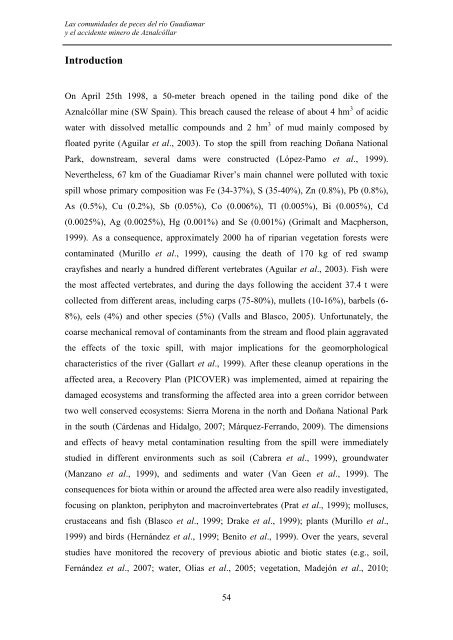las comunidades de peces del río guadiamar y el accidente minero ...
las comunidades de peces del río guadiamar y el accidente minero ...
las comunidades de peces del río guadiamar y el accidente minero ...
Create successful ePaper yourself
Turn your PDF publications into a flip-book with our unique Google optimized e-Paper software.
Las <strong>comunida<strong>de</strong>s</strong> <strong>de</strong> <strong>peces</strong> <strong>de</strong>l <strong>río</strong> Guadiamar<br />
y <strong>el</strong> acci<strong>de</strong>nte <strong>minero</strong> <strong>de</strong> Aznalcóllar<br />
Introduction<br />
On April 25th 1998, a 50-meter breach opened in the tailing pond dike of the<br />
Aznalcóllar mine (SW Spain). This breach caused the r<strong>el</strong>ease of about 4 hm 3 of acidic<br />
water with dissolved metallic compounds and 2 hm 3 of mud mainly composed by<br />
floated pyrite (Aguilar et al., 2003). To stop the spill from reaching Doñana National<br />
Park, downstream, several dams were constructed (López-Pamo et al., 1999).<br />
Neverth<strong>el</strong>ess, 67 km of the Guadiamar River’s main chann<strong>el</strong> were polluted with toxic<br />
spill whose primary composition was Fe (34-37%), S (35-40%), Zn (0.8%), Pb (0.8%),<br />
As (0.5%), Cu (0.2%), Sb (0.05%), Co (0.006%), Tl (0.005%), Bi (0.005%), Cd<br />
(0.0025%), Ag (0.0025%), Hg (0.001%) and Se (0.001%) (Grimalt and Macpherson,<br />
1999). As a consequence, approximat<strong>el</strong>y 2000 ha of riparian vegetation forests were<br />
contaminated (Murillo et al., 1999), causing the <strong>de</strong>ath of 170 kg of red swamp<br />
crayfishes and nearly a hundred different vertebrates (Aguilar et al., 2003). Fish were<br />
the most affected vertebrates, and during the days following the acci<strong>de</strong>nt 37.4 t were<br />
collected from different areas, including carps (75-80%), mullets (10-16%), barb<strong>el</strong>s (6-<br />
8%), e<strong>el</strong>s (4%) and other species (5%) (Valls and B<strong>las</strong>co, 2005). Unfortunat<strong>el</strong>y, the<br />
coarse mechanical removal of contaminants from the stream and flood plain aggravated<br />
the effects of the toxic spill, with major implications for the geomorphological<br />
characteristics of the river (Gallart et al., 1999). After these cleanup operations in the<br />
affected area, a Recovery Plan (PICOVER) was implemented, aimed at repairing the<br />
damaged ecosystems and transforming the affected area into a green corridor between<br />
two w<strong>el</strong>l conserved ecosystems: Sierra Morena in the north and Doñana National Park<br />
in the south (Cár<strong>de</strong>nas and Hidalgo, 2007; Márquez-Ferrando, 2009). The dimensions<br />
and effects of heavy metal contamination resulting from the spill were immediat<strong>el</strong>y<br />
studied in different environments such as soil (Cabrera et al., 1999), groundwater<br />
(Manzano et al., 1999), and sediments and water (Van Geen et al., 1999). The<br />
consequences for biota within or around the affected area were also readily investigated,<br />
focusing on plankton, periphyton and macroinvertebrates (Prat et al., 1999); molluscs,<br />
crustaceans and fish (B<strong>las</strong>co et al., 1999; Drake et al., 1999); plants (Murillo et al.,<br />
1999) and birds (Hernán<strong>de</strong>z et al., 1999; Benito et al., 1999). Over the years, several<br />
studies have monitored the recovery of previous abiotic and biotic states (e.g., soil,<br />
Fernán<strong>de</strong>z et al., 2007; water, Olias et al., 2005; vegetation, Ma<strong>de</strong>jón et al., 2010;<br />
54

















